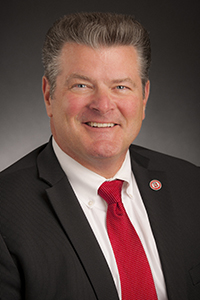Telemedicine Isn’t New—And We Should Be Glad That It Isn’t
April 30, 2020
By Chancellor, MINI��ý
 Tedd L. Mitchell, M.D.
Tedd L. Mitchell, M.D.Americans will hear the word “telemedicine” as one of the tools in the fight against COVID-19. Already, it’s been used by health experts on the airwaves and even the President at the podium of the White House press briefing room. In the weeks and months to come, many folks will have their first “telemedicine” appointment: a digital meeting with a doctor, which, for some, will become a regular part of their lives.
The MINI��ý has a history with telemedicine that stretches back much further than the current crisis. Our (MINI��ýHSC) first launched telemedicine initiatives in 1989—well before the internet was a part of our everyday lives and when the idea of “videoconferencing” was the stuff of science fiction.
We launched telemedicine to connect the then-four campuses of our university in Lubbock, Amarillo, Odessa and El Paso. The original purpose was to link those sites with rural populations. The thinking was simple: if you live in an outlying rural area, it takes time, money and energy to travel to see a doctor. And if what a doctor needs to do can be done over the phone or video, then why not build procedures to make sure you can get the same high-quality care virtually as you would in person.
By the following year, we had done just that: the first tele-consultation was conducted in 1990 between Alpine, Texas, and Lubbock, Texas. After that, we built our own technology to make it possible to see the doctor through a video screen. Since then, has done over 50,000 telemedicine consultations, serving populations in rural communities, our local schools, even our prisons. Today, our unique “Frontiers in Telemedicine” program, which trains clinical staff to be telemedicine presenters, is arguably one of the finest in the country.
The MINI��ý embraced telemedicine early, as much out of necessity as anything else. There were populations we couldn’t serve directly, people who were so far away that they spent half their time traveling to and from distant rural outposts. Instead, with advanced video, those patients could share the information they needed with a doctor, thus saving both a great deal of time and hassle.
To some, the idea of telemedicine can seem obvious: you just talk to your doctor over the phone or on the internet, right? Unfortunately, it’s not quite that simple. There are strict clinical procedures, technology systems, business rules, and even laws that apply to this kind of interaction, and medical staff and clinicians need training on all of the above. We have developed specialized training for telemedicine, and we have an examination specifically for this kind of practice. Both the training and exams are overseen by the Accreditation Council for Continuing Medical Education.
I don’t say any of this to boast—though as r of the MINI��ý, you might forgive me for that. No, I share this information to both put the general public at ease—and also to ensure that providers who begin these efforts recognize that this technology is a serious and distinct part of medical practice. Many providers will begin their first forays into virtual care, and it’s important to treat these with the same level of seriousness as we do our in-patient interactions.
COVID-19 will demand a different, urgent, and rapid scale-up of this kind of service. Part of why it’s in the public discourse now is because telemedicine does offer one important advantage: it gives doctors and other medical staff the chance to avoid contracting COVID-19 themselves. Already, we are hearing about the great strains this virus has placed on our front-line medical staff. Every bit of breathing room we can give them will help us all.
We’ve come a long way from 1989, when our telemedicine program first started. Back then, our doctors were in uncharted territory, pioneering a new delivery of care with technology that was rudimentary by present standards. Today, we’ve perfected this method, and we know telemedicine can help us in this latest medical struggle. My hope is that the patients who receive care this way, and the medical staff who provide it, benefit from the decades of work that have gone into this practice. This crisis may provide us an opportunity to shape our future, but in order to do so we must understand the lessons from our past.
About the MINI��ý
Established in 1996 and headquartered in Lubbock, Texas, the is a $2 billion higher education enterprise focused on advancing higher education,
health care, research and community outreach. Consisting of four universities – , , and – the MINI��ý System collectively has approximately 55,000 students, 17 campuses statewide
and internationally, more than 300,000 alumni and an endowment valued at over $1.3
billion.
During the 86th Texas Legislature under the leadership of Chancellor , legislative funding and authority was provided to establish a new Texas Tech University veterinary school in Amarillo and a new dental school at Texas Tech University Health Sciences Center El Paso. This will be the state’s first veterinary school in more than a century and first dental school in over 50 years. The addition of these two schools makes the MINI��ý one of only nine in the nation to offer programs for undergraduate, medical, law, nursing, pharmacy, dental and veterinary education, among other academic areas.

